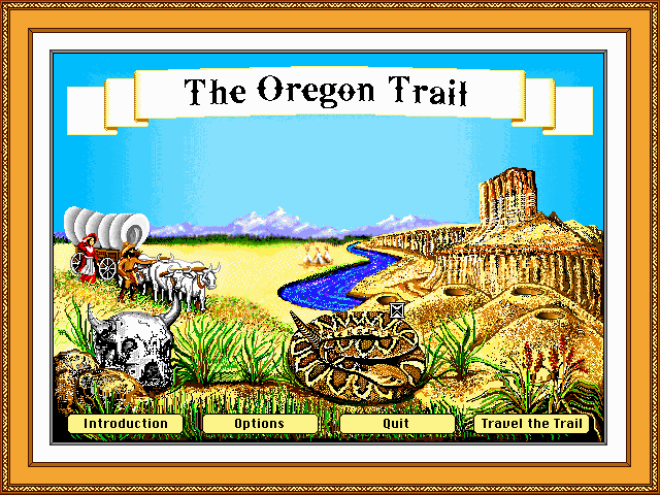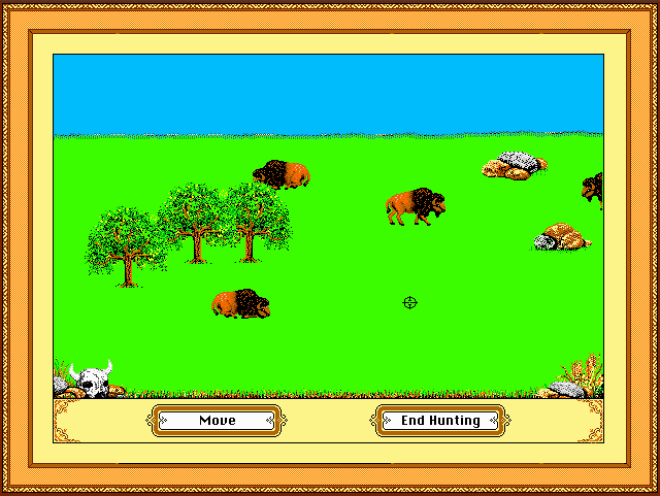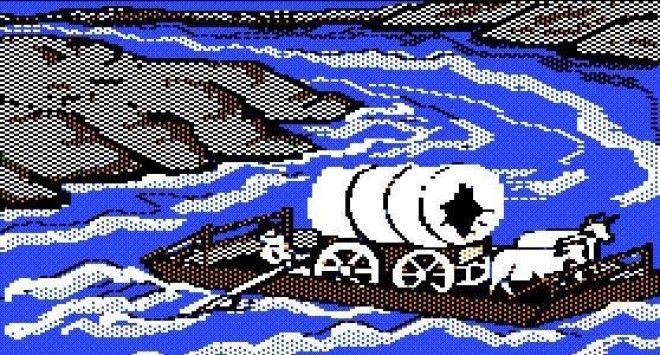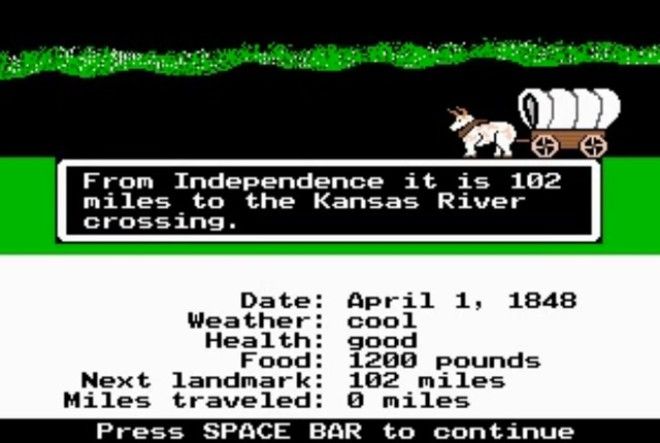We shared the experience of hunting desperately for buffalo, and having to choose whether to ford the river, or caulk the wagon and float across. The Oregon Trail was an Apple II staple in classrooms, and fond memories of the game urged me to pick up and read Rinker Buck’s memoir, The Oregon Trail: A New American Journey.
His is no recollection of a computer game, though. In the book, he and his brother embark on a far more ambitious undertaking: they buy a covered wagon, hitch it to a team of mules, and travel the actual trail, from Kansas City to Portland—six states and over 2000 miles in all. The result is a funny and poignant reflection on modernity, family, and the pioneer spirit of America. Here are 10 fun things we learned about the Oregon Trail in the 19th century and today.

1. FOR THE MOST PART, WHAT YOU SAW IN THE GAME—AND WHAT PIONEERS SAW IN THE 1800S—IS PRESERVED.
Associations such as the Oregon-California Trails Association take care of monuments and markers along the trail, as well as grave sites. They also track fence-lines to be sure that landowners do not attempt to encroach on the trail. Buck writes that today, even where it is covered by modern highways and railroad lines, the trail is charted, marked, and largely preserved as a National Historic Trail. Almost all of the trail is accessible, and much of it runs through protected federal lands. Today, there are still more than 600 miles of wagon ruts created by the original settlers. “The dreamscape terrain of natural landmarks and river views that the pioneers saw—Signal Bluff and Chimney Rock along the Platte, Devil’s Gate on the Sweetwater, Rendezvous Point at the Green—is all still there, virtually intact,” he writes.
2. AMERICAN LIFE IN THE 1850S DROVE MIGRATION ALONG THE TRAIL.
The 1840s and '50s were turbulent times in American history. As Buck describes it, “Families were disrupted and lives destroyed by the financial panics and bank failures that recurred every decade, towns were divided by bitter religious squabbling and labor strife, and the biggest political issue of the day—the spread of slavery—had degenerated into guerrilla warfare on the Kansas and Missouri frontier.” He observes that “to be American then was to be periodically unmoored, transient, so bereft of options that moving on was the only choice.” Westward expansion was a “safety valve that prevented a calamitous society from imploding.”
3. NO ONE PLANNED THE OREGON TRAIL.
The Oregon Trail happened on its own, created by the explosion of travelers moving westward in the 1840s in search of farmland, adventure, or gold. With prairie stretching seemingly endlessly in every direction, wagon travel depended heavily on the season’s river depth and the quality of grazing for animals. According to Buck, the pioneers “didn’t follow a single set of ruts worn into the prairie. They meandered along a collection of trails, requiring many choices. Each turn in the road involved considerable freedom, but also the peril of not knowing what was ahead.” As such, the trail “was really just an aggregated landscape that the pioneers followed across the plains and then the high deserts.”

4. TODAY, THE TRAIL TELLS THE STORY OF AMERICA'S ECONOMIC AND SOCIAL EXPANSION.
Many parts of the trail have been paved with highways, which annoys preservationists but also tells the story of America itself. Pioneer trails eventually became ideally suited for farmers and ranchers to drive their cattle. Cities such as Omaha and Kansas City, with their railroad yards, grew as a result. Those cattle driving trails were paved during the first World War so that animals could instead be trucked faster for slaughter, canning, and shipment to soldiers in Europe.
5. THE COVERED WAGON BUSINESS REMAINS A HUGE PART OF AMERICAN LIFE TODAY.
Over the decades, as pioneers moved west, wagon technology improved and they became lighter and more durable. Wagon manufacturing was a major part of the American economy, and many companies instrumental in the trade were still around in the 20th century, and some operate even today. Among the companies that began as wagon manufacturers, reports Buck: John Deere, Studebaker, and Sears and Roebuck.
6. THE ROAD WEST WAS PAVED WITH MULES.
Though the Oregon Trail computer game involved oxen, many pioneers on the actual Oregon Trail used mules, which were cheap, strong, and reliable. “Mule calls,” as seen in westerns, are for more than show. They are specific (“easy now!” or “whoa!”) and mules respond to them, and to their own names. (The animal would be easily trained, for example, to respond to the call “Walk lively now!” and move at 4 mph.) Mules also respond well to the caller’s mood, which is why so many callers use a sing-song style. As Buck explains, the calls mean much more than that, however, expressing also “a feeling about life, a passion for the land that is being crossed, and a love of the animals in front of you.”
Advertising
7. WE CALL THOSE WHO SETTLED THE WEST “PIONEERS”—BUT WHAT DOES THAT MEAN?
The word “pioneer” derives from the Latin word pedonem, which means “one who goes on foot.” It was applied to foot soldiers in the army. The word eventually came to mean one of lower social status, such as an infantry soldier or laborer. The evolved word for this was peon. In French, it came to mean an agricultural worker—“one who clears land”—and because of its use during 18th century wars, pionnier meant units that “go first” to prepare the path for the larger army.

8. THE PIONEERS WERE NOTORIOUS LITTERBUGS.
In The Oregon Trail, Buck explains that he brought too many items for his journey, and early in the trip discarded much of the useless gear. The pioneers in the 1840s and '50s often made the same mistake. Salesmen would sell an enormous number of “necessities” to travelers attempting the frightful, arduous move west. As the journey would unfold, pioneers would realize how little of it they actually needed (to say nothing of what a pain it was to unload and reload wagons with each river ford). “The result,” writes Buck, “was a historic American dumping.” One pioneer writer in 1855 listed dozens of items tossed by travelers not far past Salt Lake City. Included on the list: “all kinds of dishes and hollow ware, cooking stoves and utensils, boots and shoes, and clothing of all kinds, even life preservers … good geese feathers in heaps, or blowing over the Desert, feather beds, canvas tents, and wagon covers.”
9. WATER, WHETHER RAIN OR RIVER, WAS AN ENORMOUS CHALLENGE TO PIONEERS.
The weather could be terrifying and impossibly difficult. The storms in Nebraska were, to pioneers, “King Lear in the height of his madness.” Subterranean flows beneath seemingly shallow rivers could turn “into a porridge of quicksand that can swallow a man or a draft animal in less than a minute.” In the decades before these rivers were dammed, they might stretch a mile across, including mudflats, and unlike the computer game, fording a river was never a solitary affair. Wagon masters had to organize “staged fordings,” and the whole scene was invariably chaotic, with multiple wagon companies crowding and pushing to cross at the same time. Water could rise menacingly and unexpectedly mid-ford, and wagon companies might have to wait days on the riverbanks for waterlines to lower before they could cross. One historian notes that “almost every overland diary records drownings or near misses along the rivers.”
10. IF YOU TRAVEL THE TRAIL TODAY, YOU WON'T DO IT ALONE.
During Nick and Rinker Buck’s crossing of the Oregon Trail, word spread along their route, and supporters would sometimes crowd rural roadsides to catch a glimpse of a real covered wagon and modern-day pioneers. Those towns were often built by the Oregon Trail and those who crossed it, and as one observer along the trip advised them, nobody would be upset if the brothers used public campgrounds and corrals along the way. “Look,” she said, “those corrals are for you … Everybody is going to be so into this, all the way out. Your biggest problem is going to be dealing with all of the people who want to help you.”

